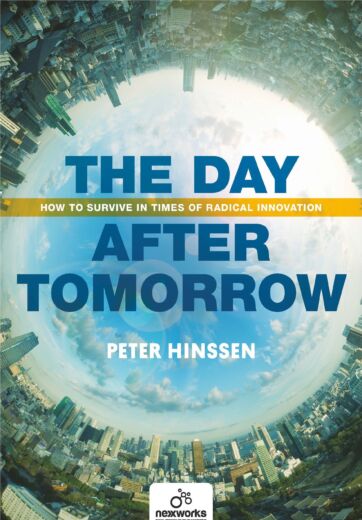An interview with Adam Pisoni
Adam Pisoni is one of the co-founders of Responsive.org, a community committed to creating and growing Responsive Organizations, as well as the co-founder and former CTO at Yammer. nexxworks Partner Peter Hinssen had a riveting conversation with Adam about digital and collaborative innovation, responsive cultures and leadership.

Peter Hinssen: Collaboration is not just a cultural characteristic of many successful companies, it is also a big disruptor. Among other things, it turns customers into competition through the sharing economy phenomenon. How can companies survive this dramatic shift?
Adam Pisoni: With the increased pace of change, the value of information is declining. When information has a long half-life, there is value in hoarding it. Today it has a short half-life and you have to get the most value of it as quickly as possible. That’s a radical change. One that many organisations have trouble dealing with.
A lot of companies are still stuck with this old preconception where employees should not be trusted with information. That’s because historically, sharing and collaboration were viewed as an increased risk. It meant that our secrets would be revealed or that others could copy our precious ideas. Those companies fail to grasp that data and ideas become obsolete fast, unless they get enriched, iterated and used by their employees. The smart move is to make sure that information is widely available, because most of the time, we are not even sure who needs what information. True, there is the danger of being copied, but you have to outrun that possibility. The alternative – the risk of not using the information you have – is way worse.
Hinssen: How should companies collaborate better and faster internally to leverage the collaborative economy?
Pisoni: The rise of technology has made Information move faster than ever. It is easy to find, reproduce and distribute. It has created this new world where new ideas spread fast and can be iterated on instantly. Obviously, this has enormous implications for companies. It means that you can no longer control information. It means that you have to collaborate and partner with customers so that everyone is in the same boat together. For me, having a common mission is the only way to diminish the incentive for your customers to compete with you. That is one of the real reasons why companies are becoming more mission driven today. This change is not so much driven by a renewed enthusiasm for ethics as some seem to claim, as it is by a pragmatic drive towards self-preservation.
We are obviously all trying to survive in a very competitive world, which is made so much harder by the fact that consumers are now less interested in owning than they are in sharing or hiring extra bedrooms, tools, car rides or driveways. That completely changes the paradigm of competition. But if your company acts like a large coalition which includes your customers, your partners and sometimes even your competition, you will have to contend with fewer parties.
Hinssen: Though most companies seem quite convinced about the increased need for collaboration with customers, it seems that a lot have no idea about how to change their culture likewise. What would you advise them?
Pisoni: They need to ask themselves first “Is my mission one my customers have as well?” Customers have to believe in your actions. They have to want to be a part of what you’re doing or it will be nearly impossible to get them to help you.
The second question is “how do I make sure that my customers are helping me make sure that I give them what they need?” Management guru Peter Drucker said “the purpose of a business is to create a customer”. A lot of us have been trying to achieve this for years, often in rather silly ways with advisory councils, surveys etc. There are better approaches. GE, for instance, introduced co-creation community FirstBuild.com where everyone could submit ideas about what they thought GE should do and then they would effectively execute what was requested. They are leveraging their customers to understand what they want and need. And the customers are excited about this and love being part of the process.
Hinssen: What are your tips for leaders who want to foster collaboration?
Pisoni: The biggest piece of advice that I have - for anybody contemplating a more decentralised and collaborative company - is that you cannot think or reason your way there. Our instincts – about how to run companies or treat employees – are so deeply ingrained that any attempt to just imagine what it would be tends to fall flat. The only way to really understand how it works is to experiment with it.
The good news is that that it is possible to experiment without affecting the entire organisation. You can just work with projects and groups on a ‘safe’ scale. We are seeing a lot of that. CEOs who say ‘we are going to do this project differently although historically we would push it down from the top’. A South American factory for instance was struggling with improving safety scores, which the leaders had not been able to do. So, with the help of the Rapid Results Institute, they elected a group of workers and leaders and had them run through the same exercise separately and come up with a solution for the problem. Then they brought them together to share. When the leaders heard what the workers had come up with, they were frankly blown away. They had been stuck in this “old” thinking that there are 2 classes of employees: the workers and the thinkers. And that the workers are supposedly too dim to think or create new ideas and therefore the thinkers had to tell them what to do. But this low risk experiment really updated their mental model.
I’d like to add that not everyone goes for the ‘low risk’ experiments, though. Some have the courage to try something pretty radical. For instance, I was working with one large enterprise that was performing mass layoffs. Instead of trying to make as little noise about it as possible, which is what usually happens, they encouraged employees to say goodbye, to voice what they liked about others and to help each other through the process on Yammer, their internal social network. That is a radical thing for a company to do and yet it was incredibly well received.
Most leaders today are scared because the world is changing so fast. They feel like they cannot solve problems fast enough. What’s even worse is that the responsibility is all theirs. It actually is a relief if they can offload some of that worry and the mental energy required to solve problems to their employees. But they will have to update their mental models about employee-management relationships.
Transformation and cultural change are all about unlearning the things that we knew to be true. That is really hard to do. When you attempt something different, it will feel wrong. But there is no choice. We will all need to adapt to our fast evolving world and the best is by experimenting in a safe way. So, just pick a project and experiment.
Hinssen: Most companies – the large ones most of all - are still built for efficiency and stability, while in these fast and disruptive times, they should be built for agility, transformation and speed. How can companies make that transformation?
Pisoni: They need this really strong new kind of leadership. Those who say “Somebody has to take the risk of more rapid evolution and I as a leader will take that on”. And they exist. Like Tony Hsieh of online store Zappos, for instance. Those that dare to experiment to shift their company into a different culture.
The good news is that a lot of companies are already changing. Luckily for most very large enterprises, they have the structural advantages that make them difficult to disrupt. So they still have a little bit of time to adapt. Most are experimenting with customer service, products, culture,… The main question is pace. Are they doing it fast enough? A lot of companies will be disrupted. The tenure of the of Fortune 500 companies is declining rapidly because they are not making the transition fast enough. The reason is this immense systemic pressure to be predictable, to plan ahead and have this dictatorial kind of leadership. You could argue that the entire economic system does not yet reward the new way of working and managing. They do not know how to think about companies that do not have any long term plans. So there is little incentive to change from that side.
An important question is: will there still be large companies at a certain point? I think the answer is “yes”. In a real networked world there should be benefits to having lots of brains, lots of creativity working together. However, will the current large companies remain the large companies? Some might. But I think it will benefit companies to do some serious introspection about the way they are functioning and their relationship to their customers because they are not all going to make it.
Hinssen: You are a disruptor yourself, having co-founded Yammer. What advice would you give to entrepreneurs with a new idea?
Pisoni: When you start a new company, usually you are very passionate about an idea or a product. But the challenge for a start-up is just as much building the company as it is making the product. I think founders especially miss that transition. All that matters for them is the product. Now that’s not a problem when they operate on their own, obviously, but when you are with a dozen people – which is actually still pretty small scale – you have to think about the company you are creating. Because at a certain point - when there are maybe 100 people working for you - it will be very hard to ‘suddenly’ shift your culture to a collaborative one.
99% of the time what happens is that mildly successful start-ups are very collaborative early on. There’s this great vibe with everyone working together And then they get to 40 people and say “well, this is not working because we have no processes”. They then fall back into the old school approach of the bigger companies. Some small SMBs are already behaving like large companies with rigid hierarchical structures. It’s important not to fall into this trap as a start-up. At Yammer we used to say “it is not about building great products, it is about building the company that builds great products”.
